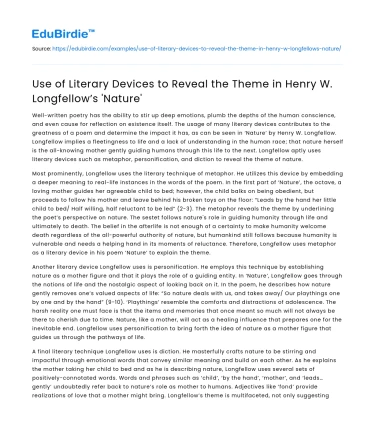Well-written poetry has the ability to stir up deep emotions, plumb the depths of the human conscience, and even cause for reflection on existence itself. The usage of many literary devices contributes to the greatness of a poem and determine the impact it has, as can be seen in ‘Nature’ by Henry W. Longfellow. Longfellow implies a fleetingness to life and a lack of understanding in the human race; that nature herself is the all-knowing mother gently guiding humans through this life to the next. Longfellow aptly uses literary devices such as metaphor, personification, and diction to reveal the theme of nature.
Most prominently, Longfellow uses the literary technique of metaphor. He utilizes this device by embedding a deeper meaning to real-life instances in the words of the poem. In the first part of ‘Nature’, the octave, a loving mother guides her agreeable child to bed; however, the child balks on being obedient, but proceeds to follow his mother and leave behind his broken toys on the floor: “Leads by the hand her little child to bed/ Half willing, half reluctant to be led” (2-3). The metaphor reveals the theme by underlining the poet’s perspective on nature. The sestet follows nature's role in guiding humanity through life and ultimately to death. The belief in the afterlife is not enough of a certainty to make humanity welcome death regardless of the all-powerful authority of nature, but humankind still follows because humanity is vulnerable and needs a helping hand in its moments of reluctance. Therefore, Longfellow uses metaphor as a literary device in his poem ‘Nature’ to explain the theme.
Save your time!
We can take care of your essay
- Proper editing and formatting
- Free revision, title page, and bibliography
- Flexible prices and money-back guarantee
Another literary device Longfellow uses is personification. He employs this technique by establishing nature as a mother figure and that it plays the role of a guiding entity. In ‘Nature’, Longfellow goes through the notions of life and the nostalgic aspect of looking back on it. In the poem, he describes how nature gently removes one’s valued aspects of life: “So nature deals with us, and takes away/ Our playthings one by one and by the hand” (9-10). ‘Playthings’ resemble the comforts and distractions of adolescence. The harsh reality one must face is that the items and memories that once meant so much will not always be there to cherish due to time. Nature, like a mother, will act as a healing influence that prepares one for the inevitable end. Longfellow uses personification to bring forth the idea of nature as a mother figure that guides us through the pathways of life.
A final literary technique Longfellow uses is diction. He masterfully crafts nature to be stirring and impactful through emotional words that convey similar meaning and build on each other. As he explains the mother taking her child to bed and as he is describing nature, Longfellow uses several sets of positively-connotated words. Words and phrases such as ‘child’, ‘by the hand’, ‘mother’, and ‘leads… gently’ undoubtedly refer back to nature’s role as mother to humans. Adjectives like ‘fond’ provide realizations of love that a mother might bring. Longfellow’s theme is multifaceted, not only suggesting a gentle, mother-like firmness in nature but attributes childish, immature oblivion to humankind. He emphasizes this through words and phrases such as ‘playthings’, ‘full of sleep’, and ‘gazing [at playthings]’. Longfellow depicts the transition through the phases of life to death as guided by Mother Nature acutely and kindly through his words: he acknowledges the apprehension one might have in regards to change while setting a calm tone through his diction intended to pacify and provide reassurance for what is to come.
Through metaphor, diction, and personification, Longfellow spins a deeply impactful poem. He conveys how humans’ eyes are clouded over by sleepy oblivion, unknowing and guided through their lives and purposes by gentle Mother Nature. Inherently timeless, Longfellow’s message stands true and will remain so for generation after generation: nature will continue to execute her plan for every last body on Earth.






 Stuck on your essay?
Stuck on your essay?

